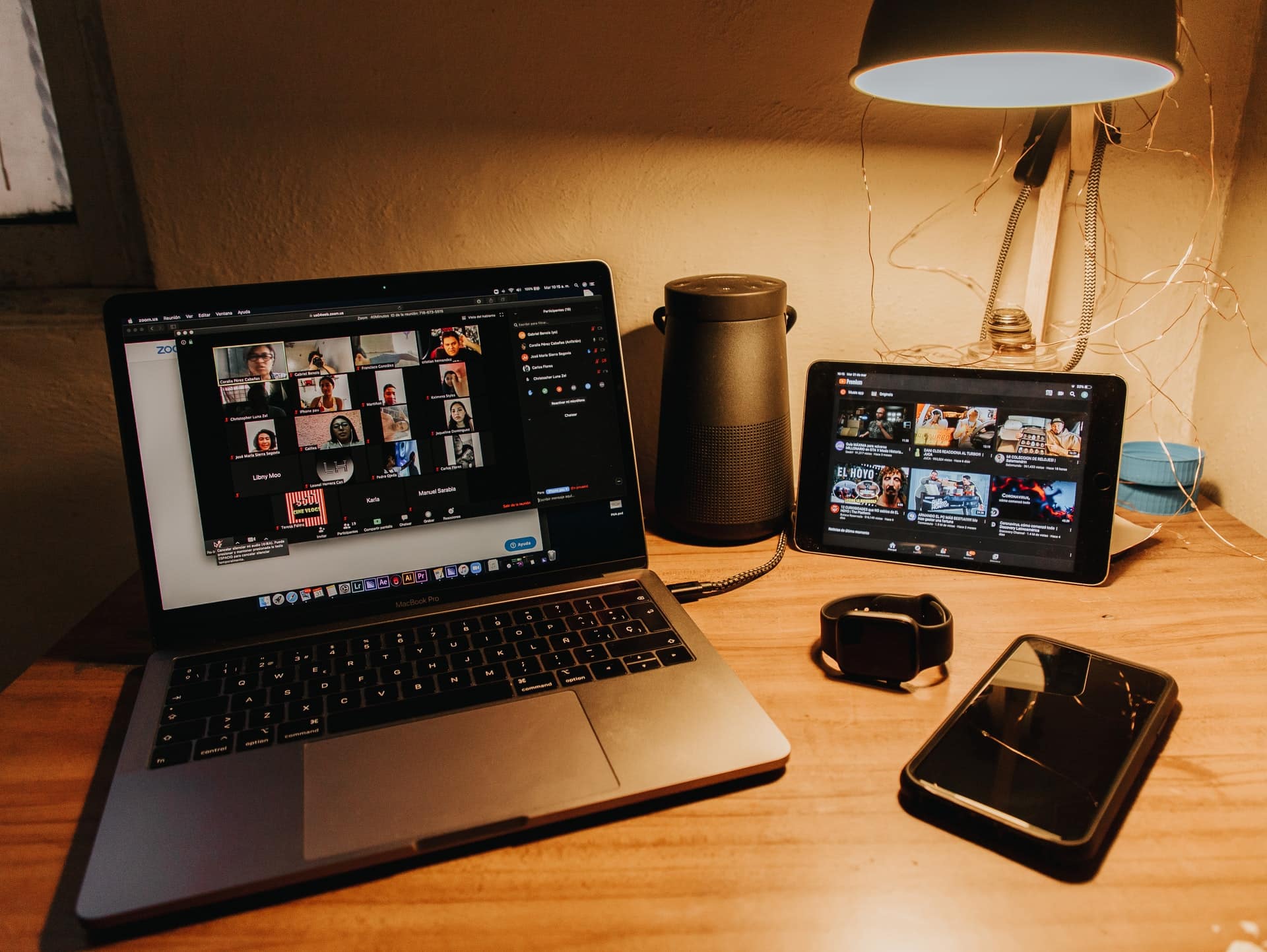During the coronavirus lockdown, many improv companies have been experimenting with online shows. Oakville Improv (my home company) has been experimenting with different formats to small audiences since March 2020. Here I’ll share some tips we’ve learned for improv on Zoom. And I’ll include ideas for adding environment and physicality to your online improv scenes.
You might think that film and TV actors would have an advantage when improvising over a video stream. They don’t — improv on Zoom differs greatly from simple camera work. The big problem is eye contact. To play “out” to the audience, you need to look right into the camera lens. But this takes your eyes off the screen, so you can’t really watch and react to a scene partner. The lack of visual cues leads to a lot of over-talk, so it’s even more important to listen and take your time.
General Tips for Improv on Zoom
Prepare in advance
Wrangle your technology to get the best video performance. Performers should connect to the call early and test the connection strength. Shut down any unnecessary apps on your device so they don’t hog extra bandwidth. Pause or close sync apps like Dropbox or OneDrive.
If you’re going to be sharing anything on your screen as part of the presentation, have the files open and ready. Practice sharing so you know the keystrokes.
We experimented with sharing video (for a voice-dubbing scene), but it’s tricky because of potential lag. If the improviser can’t see it running smoothly, it won’t work. If you try it, don’t stream it directly from YouTube or elsewhere. Download the video to your local device and play it from there.
Use a producer (more than one)
The video meeting host controls all aspects of the broadcast, including muting audience members. Your show’s host can do this, but it’s easier to have someone dedicated to the controls.
Ideally, you could have more than one person doing this, with different jobs to focus on. You’ll probably need a paid account for that feature.
Set yourself up for success
Explore ALL the settings in your video meetings app. Learn the keystrokes for quick-mute and camera on/off.
Most video apps “mirror” your video back to you, so you see yourself as you’re used to in the mirror. Consider turning this off so you can see exactly what the audience sees. If it’s important for you to point to the left or right, you’ll want to know how it looks to observers.
It’s tough working without the feedback of laughter. Performers (or at least the host) can leave their microphone open to offer some sound. Keep all audience members muted.
Upgrade your lighting
Webcams need lots of light to perform well. Experiment with your settings to adjust light sensitivity.
Avoid general overhead lights, which wash you out and cast shadows down your face. Use a lamp at eye-level behind your device to get better lighting. Better yet, use more than one, placed at different heights, to cut down on shadows. Keep lamps out of your background — they will bloom and overexpose the video.
If you have the budget, another option is an LED ring light. They’re sold for selfie photography, and mount easily on a display monitor or smartphone right over the webcam lens. The light is more omni-directional and beams directly into your face, which improves the video.
Set the audience up for success
Prepare setup instructions for audience members to get the best experience. Send these in advance with the meeting invitation. You could make a dedicated page on your website, and include screen shots of how to set up the various options. This will take a bit of work, but it’s completely worth it.
Tell your audience to arrive a few minutes early so you can review the setup instructions with them. Have them all change their screen name to “Audience” so you can identify them.
You may have to consider locking latecomers out of the show, so someone doesn’t pop up in the middle of a scene. Or use the Waiting Room function to let people in when there’s a suitable break in the show.
If audience interference is a genuine concern, you could also consider different streaming options, like YouTube or Twitch. You can still do the improv on Zoom without worrying about being bombed, or someone accidentally switching on audio or video.
Use Gallery View
Everyone should always use Gallery View. This keeps the video from changing to a different speaker every time someone makes a noise. Set it to hide non-video participants and you’ll make the individual screens bigger. Only performers in a scene should have their camera on. (Voiceover and off-stage characters can unmute their audio.)
Remember that Gallery View doesn’t present in the same order on everyone’s screen. So you can’t reliably “turn” to face the person on your left.
Environment and Physicality for Improv on Zoom
Is it possible to be more physical while performing on a livestream?
The mostly fixed format of a video call is quite limiting, especially for someone like me who’s used to physicality. I feel like a lot of ideas have to be tossed out, because putting them into use means getting up and moving out of the frame.
Mostly, you have to maintain a head and shoulders view so you can be seen in a Gallery View with a large group. So how can you put movement and environment into your improv?
Some ideas:
Be affected by your environment.
This is the biggest one, anytime. Improv is about being affected by what goes on around you. You can’t perform in a scene without being affected by dialogue, character actions, emotions, etc. It’s the same for your environment. On a video stream, you’ll need to be more specific about how it’s doing so.
Consider temperature, sounds, smells, and anything else that might affect you in the place you’re in. What might you see in the environment? What’s going on around you?
Use props
Unfortunately, object work on Zoom just doesn’t seem to work very well. We’re all too conditioned from watching film and TV with realistic objects. Gather props, hats, glasses, and other accessories close by. You can switch up what you’re wearing to show environment. For example, wearing a jacket if it’s cold.
For some neat visuals, match props with your partners. This gives you the option to “give” something into the camera, and your partner “receives” it out the other end. We did this with one character handing a tissue to a crying friend.
Keep your object work clear
Despite the above, you can still try to handle improvised objects if it becomes necessary to the scene. Detail is even more important to help people read what you’re doing. Make sure your hands are out front and visible in the frame. Take your time and keep your movements small. If you’re too big, or too quick, your broadcast may be laggy.
Use the frame
Being on camera doesn’t mean you have to stay on camera. You can exit and enter from different sides of the frame. In one of our shows I did a swimming scene, where I popped up from the water by jumping up from below.
Change camera angles
Experiment with your webcam settings. I found that on Zoom, you can adjust the rotation of the video frame. One thing I tried was upside down. By putting my arms up over my head, and swaying side-to-side, it looked like I was hanging from the ceiling by my ankles. A limited use situation, but something to play with.
Get more space
Not everyone has the space to move around. But if you have room to step back from the camera and move with your whole body, that’s ideal. Even if you’re trapped at a desk in a tiny office, you might make some space for spinning in your chair, or moving out of frame.
Move the device
Using Zoom on your phone or tablet might give you more freedom to move around. (The tradeoff is that certain parts of the app will be missing or limited, like Chat or a lot of screens in Gallery View.) Being able to move to different parts of your space sets you up for environment switches. You could stage different backdrops around the room. Turn off your camera as you move around so it’s not distracting or causing people vertigo.
Try cinematic tricks
You’re working in front of a camera, so it’s a great time to try creative shots. In one scene, my friend James Jeffers “embraced” another character, then spun in place so the background behind him whipped around. It looked like the classic “hug and turn” shots we see in many romance movies. Funny stuff. And if both players can synchronize it…
If you’re using a wireless device, and have an extra person with you, they can move the camera around you. You could also try your own panning or tracking shots. Again, be careful of too much camera movement so viewers don’t get dizzy.
Mind your Background
Watching people perform from their home office or living room quickly shows you the value of a theatre’s blank stage. The sight of bookshelves or furniture in the background undermines any sense of place you might try to create. Use a neutral, distraction-free background like a bare wall.
If you have the budget, consider a photography background kit. They’re relatively inexpensive and include the rigging to hang a drape behind you. Black drapes highlight you best. Some kits are also bundled with lights, but consider the expense. How much use do you expect to get out of this equipment? Most times, hanging a simple bedsheet is just fine.
What about Virtual Backgrounds? By now, everyone has tinkered with this feature. (Zoom even has a monthly contest for the most creative.) It can be a good way to set a scene — especially if all players use the same one — but you really need to use it with a proper green screen. Zoom’s adaptive view gets easily confused by a lot of movement. Use lots of light on the green screen – shadows can cause glitches in the rendering.
Be patient and keep innovating!
Restrictions always make improv more difficult, and that’s frustrating. But this is a unique opportunity to create something that no one else has before. Slowly but surely, we’re pushing the boundaries.
Please share your tips for improv on Zoom
Is your theatre group experimenting with improv on Zoom or other video meeting software? What good or bad experiences have you had? Any online improv tips to share? Leave a comment below and help the community!
Photo by Gabriel Benois on Unsplash.


